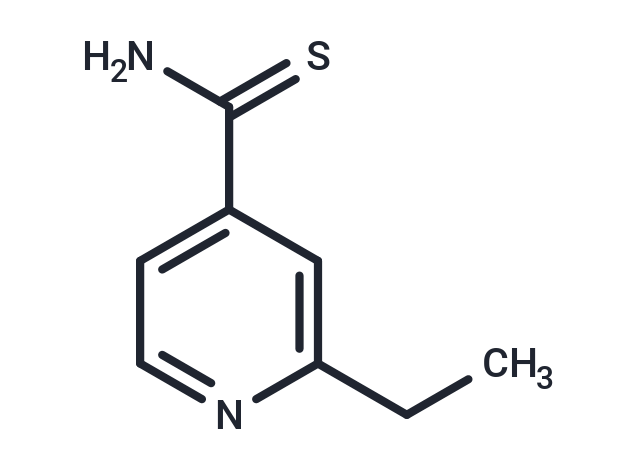 Your shopping cart is currently empty
Your shopping cart is currently empty

Ethionamide (2-ethylthioisonicotinamide) is a nicotinamide derivative, with antibacterial activity, used to treat tuberculosis. Although the exact mechanism of action of ethionamide is unknown, it may inhibit the synthesis of mycolic acid, a saturated fatty acid found in the bacterial cell wall, thereby inhibiting bacterial cell wall synthesis. This eventually leads to bacterial cell wall disruption and cell lysis. Ethionamide may be bacteriostatic or bactericidal in action, depending on the concentration of the drug at the site of infection and the susceptibility of the organism involved.

| Pack Size | Price | USA Warehouse | Global Warehouse | Quantity |
|---|---|---|---|---|
| 200 mg | $31 | In Stock | In Stock | |
| 500 mg | $50 | - | In Stock | |
| 1 g | $66 | - | In Stock | |
| 1 mL x 10 mM (in DMSO) | $53 | In Stock | In Stock |
| Description | Ethionamide (2-ethylthioisonicotinamide) is a nicotinamide derivative, with antibacterial activity, used to treat tuberculosis. Although the exact mechanism of action of ethionamide is unknown, it may inhibit the synthesis of mycolic acid, a saturated fatty acid found in the bacterial cell wall, thereby inhibiting bacterial cell wall synthesis. This eventually leads to bacterial cell wall disruption and cell lysis. Ethionamide may be bacteriostatic or bactericidal in action, depending on the concentration of the drug at the site of infection and the susceptibility of the organism involved. |
| In vitro | Ethionamide is a structural analogue of isoniazid (INH), both are pro-drugs that need to be activated by mycobacterial enzymes to exert their antimicrobial activity. Ethionamide mechanism of action is thought to be identical to INH although the pathway of activation is distinct from that of INH. Ethionamide is activated by an EthA enzyme, leading to the formation of a Soxide metabolite that has considerably better activity than the parent drug. [1] Ethionamide inhibits both biofilm formation and viability of mature biofilms. Ethionamide reduces the content of ergosterol in Cryptococcus spp. planktonic cells and destabilized or permeabilized the fungal cell membrane, leading to leakage of macromolecules. [2] Ethionamide is in general toxic at concentrations above 0.50 mM to HepG2, Caco-2, and RAW macrophage cells, but the toxicity is drastically reduced when Ethionamide is loaded into the microparticles. Ethionamide shows a fast metabolization process in the presence of the thermally carbonized- Porous silicon (TCPSi) particles. [3] Ethionamide is activated in Mycobacterium tuberculosis by the protein encoded by the gene Rv3854c. Ethionamide appear to disrupt cell wall biosynthesis and have at least one common cellular target, the enoyl-acyl carrier protein reductase InhA. [4] |
| Synonyms | Ethinamide, Bayer 5312, 2-ethylthioisonicotinamide |
| Molecular Weight | 166.24 |
| Formula | C8H10N2S |
| Cas No. | 536-33-4 |
| Smiles | C(N)(=S)C=1C=C(CC)N=CC1 |
| Relative Density. | 1.17 g/cm3 |
| Storage | Powder: -20°C for 3 years | In solvent: -80°C for 1 year | Shipping with blue ice/Shipping at ambient temperature. | ||||||||||||||||||||||||||||||||||||||||
| Solubility Information | Ethanol: 14 mg/mL (84.22 mM), Sonication is recommended. H2O: < 1 mg/mL (insoluble or slightly soluble) DMSO: 75 mg/mL (451.15 mM), Sonication is recommended. | ||||||||||||||||||||||||||||||||||||||||
| In Vivo Formulation | 10% DMSO+40% PEG300+5% Tween 80+45% Saline: 5 mg/mL (30.08 mM), Sonication is recommended. Please add the solvents sequentially, clarifying the solution as much as possible before adding the next one. Dissolve by heating and/or sonication if necessary. Working solution is recommended to be prepared and used immediately. The formulation provided above is for reference purposes only. In vivo formulations may vary and should be modified based on specific experimental conditions. | ||||||||||||||||||||||||||||||||||||||||
Solution Preparation Table | |||||||||||||||||||||||||||||||||||||||||
Ethanol/DMSO
DMSO
| |||||||||||||||||||||||||||||||||||||||||
| Size | Quantity | Unit Price | Amount | Operation |
|---|

Copyright © 2015-2025 TargetMol Chemicals Inc. All Rights Reserved.